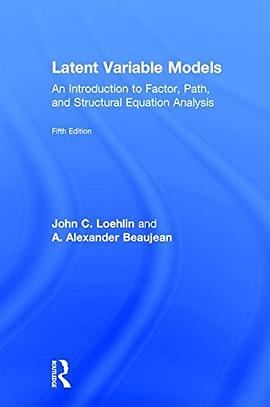Latent Variable Models
豆瓣
An Introduction to Factor, Path, and Structural Equation Analysis, Fifth Edition
John C. Loehlin / A. Alexander Beaujean
简介
Latent Variable Models: An Introduction to Factor, Path, and Structural Equation
Analysis introduces latent variable models by utilizing path diagrams to explain the
relationships in the models. This approach helps less mathematically-inclined readers to grasp the underlying relations among path analysis, factor analysis, and structural equation modeling, and to set up and carry out such analyses. This revised and expanded fifth edition again contains key chapters on path analysis, structural equation models, and exploratory factor analysis. In addition, it contains new material on composite reliability, models with categorical data, the minimum average partial procedure, bi-factor models, and communicating about latent variable models.
The informal writing style and the numerous illustrative examples make the book
accessible to readers of varying backgrounds. Notes at the end of each chapter
expand the discussion and provide additional technical detail and references. Moreover, most chapters contain an extended example in which the authors work through one of the chapter’s examples in detail to aid readers in conducting similar analyses with their own data. The book and accompanying website provide all of the data for the book’s examples as well as syntax from latent variable programs so readers can replicate the analyses. The book can be used with any of a variety of computer programs, but special attention is paid to LISREL and R.
An important resource for advanced students and researchers in numerous disciplines in the behavioral sciences, education, business, and health sciences, Latent Variable Models is a practical and readable reference for those seeking to understand or conduct an analysis using latent variables.
contents
Preface ix
Chapter 1: Path Models in Factor, Path, and Structural Equation
Analysis 1
Path Diagrams 2
Path Analysis 7
Factor Models 16
Structural Equations 23
Original and Standardized Variables 24
Manifest Versus Latent Variable Models 28
Extended Example 28
Notes 31
Exercises 33
Chapter 2: Fitting Path Models 37
Iterative Solution of Path Equations 37
Matrix Formulation of Path Models 42
Full-Fledged Model-Fitting Programs 46
Fit Functions 54
Hierarchical χ2 Tests 63
Descriptive Criteria of Model Fit 69
The Power to Reject an Incorrect Model 72
Identification 76
Missing Data 78
Correlations Versus Covariances in Model Fitting 82
Extended Example 84
Notes 86
Exercises 91
Chapter 3: Fitting Path and Structural Models to Data from a Single
Group on a Single Occasion 95
Structural and Measurement Models 95
Confirmatory Factor Analysis 100
Some Psychometric Applications of Path and Structural Models 103
Structural Models—Controlling Extraneous Variables 111
Models with Reciprocal Influences and Correlated Errors 115
Nonlinear Effects Among Latent Variables 120
Extended Example 124
Notes 126
Exercises 129
Chapter 4: Fitting Models Involving Repeated Measures, Multiple
Groups, or Means 133
Models of Events Over Time 133
Models Comparing Different Groups 142
Fitting Models to Means as well as Covariances 151
The Versatility of Multiple-Group Designs 159
Models with Categorical Indicators 160
A Concluding Comment 163
Extended Example 163
Notes 166
Exercises 169
Chapter 5: Exploratory Factor Analysis—Basics 171
Factor Extraction 174
Estimating Communalities 179
Determining the Number of Factors 183
Rotation 189
An Example: Thurstone’s Box Problem 197
Factor Analysis Using Packaged Programs 201
Extended Example 204
Notes 205
Exercises 208
Chapter 6: Exploratory Factor Analysis—Elaborations 211
Rescalings—Alpha and Canonical Factors 211
Alternative Stopping Criteria 214
Alternative Rotation Methods 217
Estimating Factor Scores 220
Hierarchical Factors 225
Nonlinear Factor Analysis 232
Extended Example 235
Notes 240
Exercises 241
Chapter 7: Issues in the Application of Latent Variable Models 243
Exploratory Modification of a Model 243
Alternative Models 248
Can Path Diagrams be Constructed Automatically? 252
Modes of Latent Variable Analysis 255
Advanced Topics in Latent Variable Models 260
Criticisms of Latent Variable Modeling 263
Notes 268
Exercises 271
Appendices 273
A. Simple Matrix Operations 273
B. Derivation of Matrix Version of Path Equations 281
C. LISREL Matrices and Examples 284
D. Model Fit Indices 289
E. Table of Chi-square Values 299
F. Noncentral Chi-square Values for Estimating Power 301
G. Power of a Test of Poor Fit and Sample Sizes Needed for Power 303
H. Communicating About Latent Variable Models 305
Answers to Exercises 309
References 321
Index 367